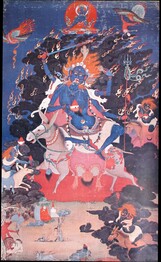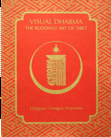Dharmapalas
Dharmapala means “guardian of the teaching.” The function
of the dharmapala is to protect the practitioner from deception
and sidetracks. If the practitioner ventures onto dangerous ground,
unhealthy for his progress on the path, the dharmapala principle
pulls him back violently. As the practitioner becomes more closely
identified with the teaching, the energy
of the dharmapalas begins to fall under his control. A student cannot,
however, come in contact with his dharmapala principle until his
guru has brought him into relationship with his yidam.
The
two main types of dharmapalas are mahakalas (male) and mahakalis
(female), on the one hand, the lokapalas on the other. All dharmapalas,
with the exception of most lokapalas are wrathful. The mahakalas
wear the ornaments and bear the attributes of herukas. Maha
means “great”; kala, kali means “black.”
Thus they are usually black or dark in color. The main role of the
mahakalas is to fulfill the four karmas or enlightened actions.
These are pacifying, enriching, magnetizing and destroying. Pacifying
means causing psychological imbalance or physical sickness to subside.
Enriching means imbuing experience with a sense of richness; also
giving physical wealth and long life. Magnetizing means attracting
power and powerful relationships, which give control over situations.
Destroying means annihilating confusion and obstacles. 
The
mahakalis also wear the bone and jewel ornaments. They usually ride
a horse or mule, from whose saddle hangs a goatskin bag of poison,
which kills the enemies of the teaching. They also carry a mirror
of judgment, a snake lasso and a bow and arrows. They are fierce
and swift in destroying whatever obstructs the dharma. They are
also tricksters who deliberately lead one into trouble if one’s
attention lapses. They create hallucinations which can deceive even
Yama, the lord of death. They are mistresses of the realm of passion
and can seduce one into samsaric involvements. They can save one
from confusion or drag one into the pain of dark age – disorder,
famine, plague. For the accomplished yogi, they act as maidservants,
carrying messages and doing services.
The
lokapalas are protectors of the teaching and also of the nation.
They are for the most part, deities from the pre-Buddhist Pon tradition
of Tibet that have been transformed by the Buddhist outlook. Notable
exceptions to this are the  guardians
for the four directions, preserved from Indian iconography. Dhrtarastra
(T.: Yukhorkhyong; Tt.: yul ‘khor skyong) is the guardian
of the east; he is usually white and plays a lute. Virudhaka (T.:
Phakyepo; Tt.: ‘phags skyes po), the guardian of the south,
is usually blue and carries a sword. Virupaksa (T.: Chenmizang;
Tt.: spyan mi bzang), the guardian of the west, is red and holds
a small stupa. Vaisravana (T.: Namtose; Tt.: rnams thos sres) is
the guardian of the north; he is yellow and carries a banner. guardians
for the four directions, preserved from Indian iconography. Dhrtarastra
(T.: Yukhorkhyong; Tt.: yul ‘khor skyong) is the guardian
of the east; he is usually white and plays a lute. Virudhaka (T.:
Phakyepo; Tt.: ‘phags skyes po), the guardian of the south,
is usually blue and carries a sword. Virupaksa (T.: Chenmizang;
Tt.: spyan mi bzang), the guardian of the west, is red and holds
a small stupa. Vaisravana (T.: Namtose; Tt.: rnams thos sres) is
the guardian of the north; he is yellow and carries a banner.
The adoption
of existing national deities by Buddhism is not unique to Tibet
but also took place in China and Japan, where Taoist and Shinto
deities were incorporated into the Buddha-dharma. The lokapalas
are usually depicted riding a horse, wearing a suit of armor and
bearing suitable attributes such as various weapons, pennons and
banners, wish-fulfilling gems in a gold dish, lassos, etc. They
are regarded by Buddhism as aspects of the national ego transmuted
into destroyers of frivolous activities, unacceptable to the teaching.
back
to top
...........................................................................................................................................................................................................
Essay © 1975 Chogyam Trungpa Rinpoche
copyright © 2003 Shelly and Donald Rubin Foundation
|

